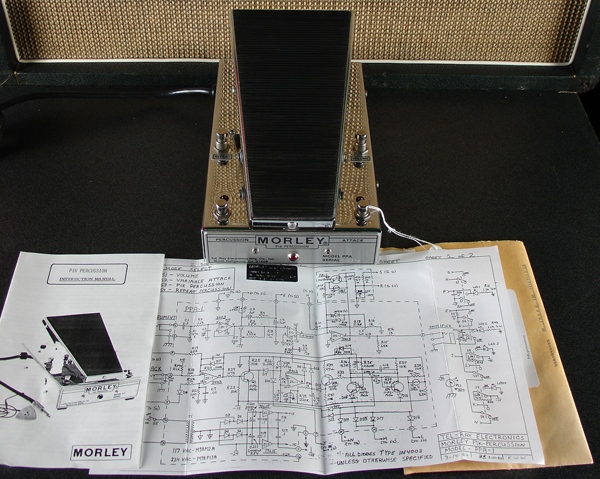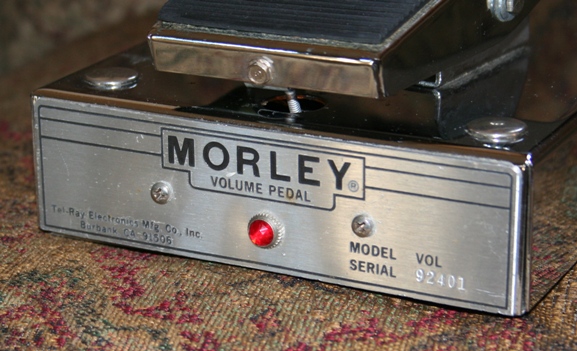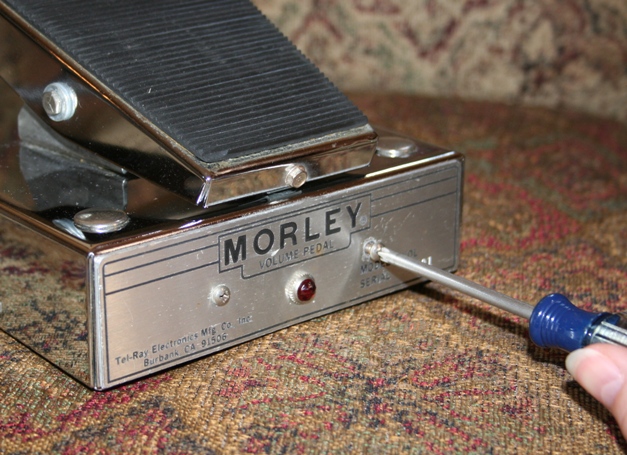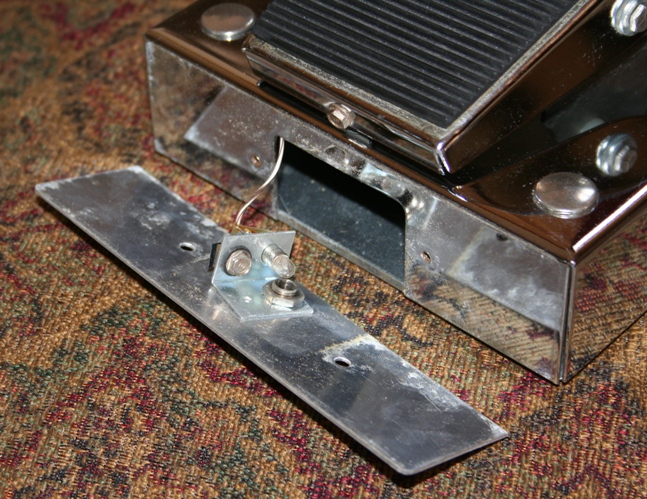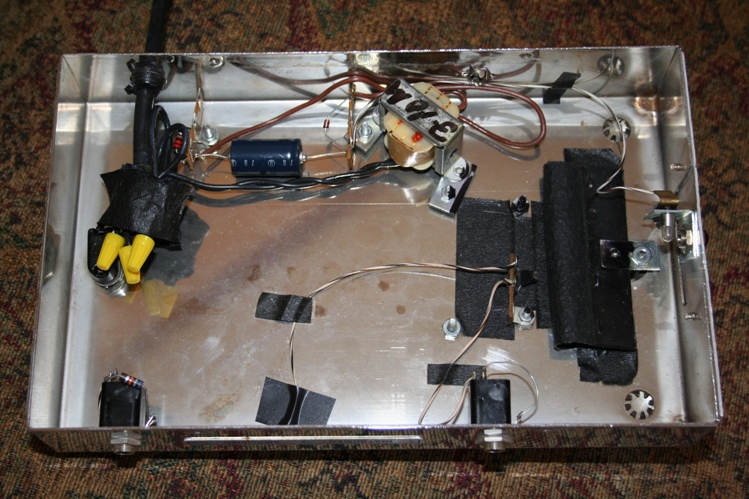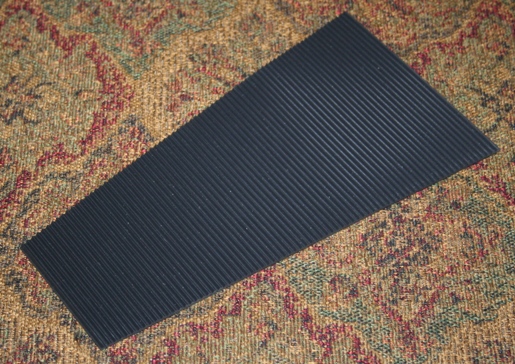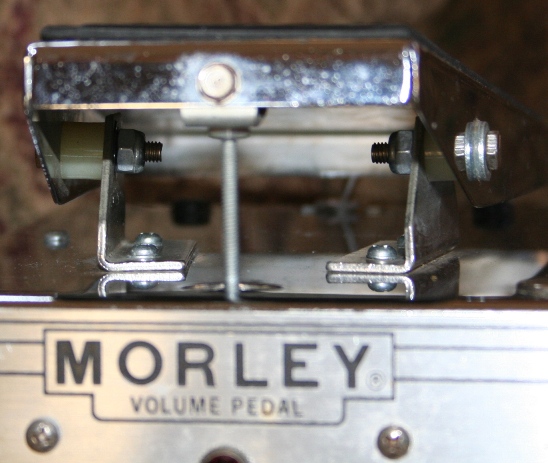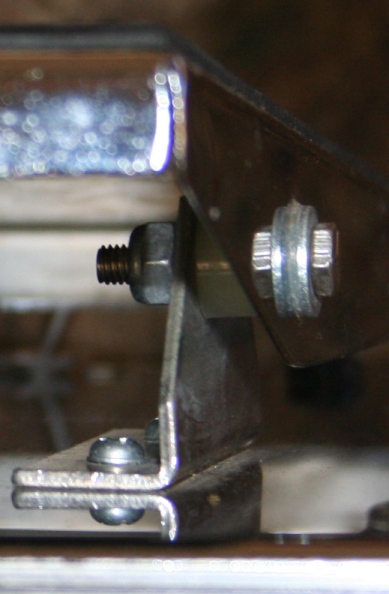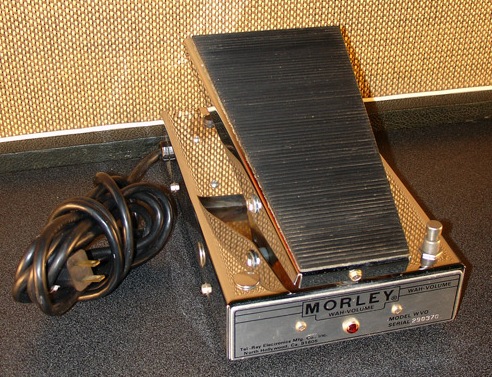MAINTENANCE TIPS
This webpage covers a few simple maintenance procedures for the tall chrome Morley pedals manufactured by Tel-Ray Electronics, Inc. in the Los Angeles, California area during the 1970's.
See this guy ?
First, the usual disclaimer and caveats. Tel-Ray Morleys are AC powered and have 120VAC running around inside them. Before working on your Tel-Ray Morley (or any AC device), make sure that you turn off the power and UNPLUG IT FROM THE WALL! There are potentially lethal AC voltages inside a Tel-Ray Morley!!! Make sure your Morley is unplugged before you start to work on it! Also, if you aren't the technical type, take your pedal to someone who is qualified.
See that transformer and those big wires? That's 120 Volts AC, dude !!!
Also, don't touch any capacitors - even when your Morley is off and unplugged.
The indicator bulb on Tel-Ray Morleys serves two functions. Located behind a red jewel-type cover, it indicates when the power is on, but more importantly, it provides the light source to drive the LDRs (Light Dependent Resistors). If the bulb behind that red jewel cover goes out, your Morley is dead and will not operate. Fortunately, it's easy to replace the bulb - and you DO NOT need to remove the bottom plate off the pedal.
To change the bulb, follow these simple steps. First, turn your Morley pedal OFF and UNPLUG IT FROM THE WALL! Then, simply remove the two Phillips screws located on the Morley SERIAL NUMBER panel. Then, carefully pull the panel out a couple of inches - but only a couple of inches - your don't want to break any of the attached wires. The bulb is held in pace by a clip. Slide the old bulb out and put a new one in. Put the cover back on, replace the Phillips screws, and you're done. Tel-Ray Morleys use a 387 type bulb, which is pretty common and can be found at electronics supply stores, or on the Internet, or you can contact Morley for replacements.
The driving force behind a Tel-Ray Morley - the 387 light bulb. If this bulb burns out, your Tel-Ray Morley is dead. Tel-Ray Morleys use a very simple shutter design to control the amount of light reaching the LDR(s). A piece of opaque black canvas-like material is held in place by a clamp on the pedal end and adhesive and/or tape on the chrome housing end. The shutter material is that black material that was used on school window blinds in the old days when the teacher wanted to use a movie projector to show an 8mm or 16mm movie film to the class (okay, now I'm REALLY dating myself!). It's not unusual for the adhesive or tape to loose its grip as the pedal ages. You simply have to re-glue the shutter or tape it in place. In order to do this, you will have to remove the four small hex screws (two on each side) to remove the bottom plate and gain access to the shutter mechanism. TURN OFF YOUR MORLEY AND UNPLUG IT FROM THE WALL BEFORE YOU REMOVE THAT BOTTOM PLATE! There are potentially lethal AC voltages inside a Tel-Ray Morley! It's important to get the shutter assembly back in its original location or you will affect the sweep of the pedal. You can usually see where the shutter was originally located by the marks left behind by the glue or tape residue on the housing. Be especially careful with the LDRs since their leads can easily be bent or broken. If you accidentally bend the leads, you will have to re-adjust them (re-bend them) to put them back into location so that the sweep of the pedal is correct. There's a lot of trial and error in this adjustment so don't attempt this if don't have the patience and technical ability.
The heart and soul of a Tel-Ray Morley - the Light Dependent Resistor (LDR) and the shutter. The rubber pad on the treadle of Tel-Ray Morleys is held in place by glue. It often dries out over time and then the rubber pad falls off. Simply clean the pad with dishsoap and water, or, if necessary, with a mild solvent like alcohol, removing the old glue. Clean any residue off the metal treadle - you can use PVC cleaner on the metal treadle, but be careful not to get it inside the pedal or on any plastic parts (like the nylon bushings that hold the treadle in place). Re-glue the rubber pad to the treadle - I use yellow contact cement because it stays fairly flexible for a long time. The two large screws that hold the treadle to its bracket can become loose over time, allowing the pedal to flop around when you take your foot off of it (its really annoying when you take your foot off of your Morley Volume Pedal and have the volume go to full tilt or off!). If your treadle becomes loose you can simply re-tighten the screws. However, you will have to use two wrenches on each screw - one to hold the nut and another to tighten the screw. Do not overtighten the screws! There is a white nylon bushing between the treadle and its bracket and you don't want to damage it. When properly adjusted, your Tel-Ray Morley should stay in place when you take your foot off of it, but it shouldn't be hard to move it back and forth. Sometimes the AC power cord on an old Tel-Ray Morley becomes damaged and has to be replaced. That procedure is beyond the scope of this article. If you don't know how to change a power cord, don't attempt it! However, here's a note for technicians. Many early Tel-Ray Morleys use un-polarized (2-prong) AC power cords, but even then, there is a right and wrong way to connect the pedal to the wall. In some situations it doesn't matter, but plugging the AC cord in backwards (upside down) often introduces buzz or hum into a guitar rig - worse, yet, it creates a possible shock hazard. I always replace the AC power cords on those units with three-prong (polarized) plugs. The use of a three-prong plug insures proper polarity even if the ground wire is not connected. When hooking up the new power cord, pay close attention to the AC polarity - black is hot, white is neutral - if you you don't already know this stuff you shouldn't be working on your power cord! Vintage Morley pedals have AC inside, and because of that, they are susceptible to hum. If your AC powered Morley is exhibiting AC hum, you need to try to track down the cause. Sometimes you can eliminate (or at least minimize) the hum by keeping the audio wires away from the AC. Back in the day, I bought a brand new Morley EVO-1A Echo/Volume Pedal, and straight out of the factory, it had a nasty hum. I opened it up and found that one of the audio lines had flopped over and was lying next to the AC transformer so I moved it. Walla - no hum! I used black electrical tape to secure that audio wire so it wouldn't happen again. That did it - problem fixed. Unfortunately, some models are worse than others. I have a Wah/Volume pedal that always has a low-lying hum no matter what I do. Oh well.
If it ain't made of CHROME, it won't have the TONE!
Back to the Tel-Ray Morley Page
Wingspread Records Homepage

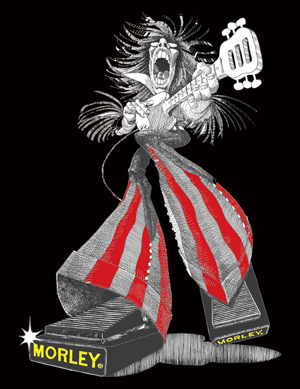
He forgot to turn his Morley off and unplug it from the wall before working on it.
As cool as he looks - what he did was NOT cool ! Don't be stupid.
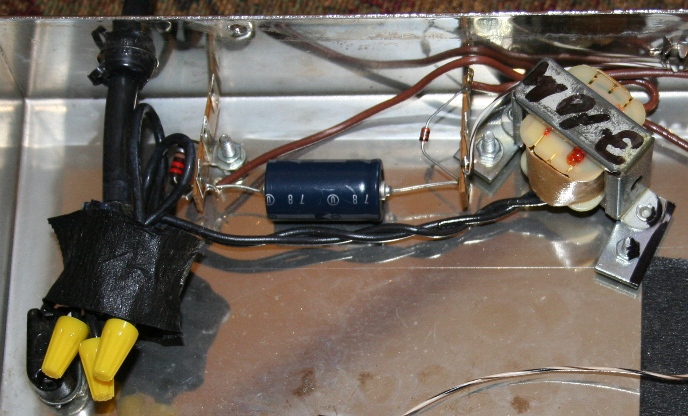
Make sure your Tel-Ray Morley is turned off and unplugged from the AC wall outlet before you open this baby up!
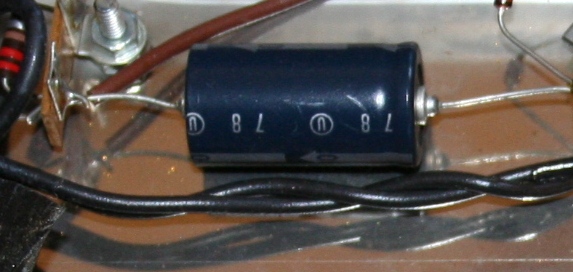
Large capacitors can hold a charge for several hours.
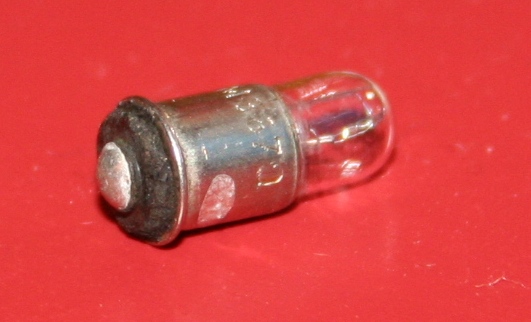
Fortunately, 387 bulbs are cheap. You can get them at Mouser Electronics (http://www.mouser.com) for about 50 cents.
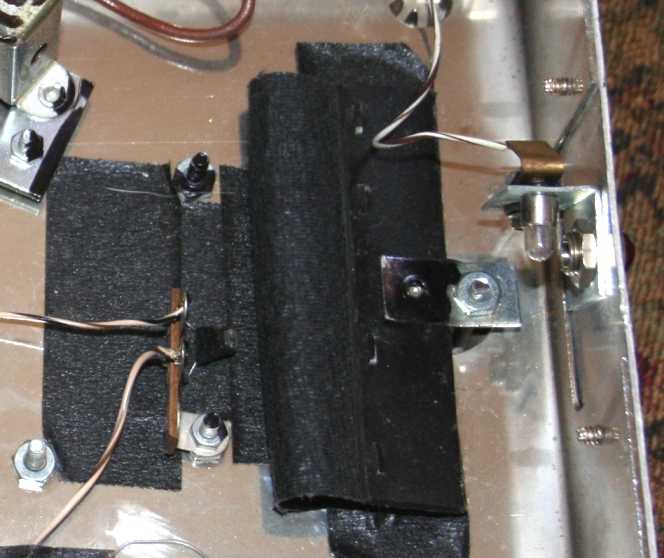
The audio signal is routed through the LDR (striped wires in the lower left of photo).
The shutter controls the amount of light reaching the LDR.
The light source is the 387 bulb (with striped wire in upper right of photo).
The amount of the light reaching the LDR changes its resistance.
Lots of light, no resistance, lots of signal. No light, maximum resistance, no signal.
And everything in between. Smooth taper. Very smooth.
Copyright © 2025 Wingspread Recording Ltd. Co.
